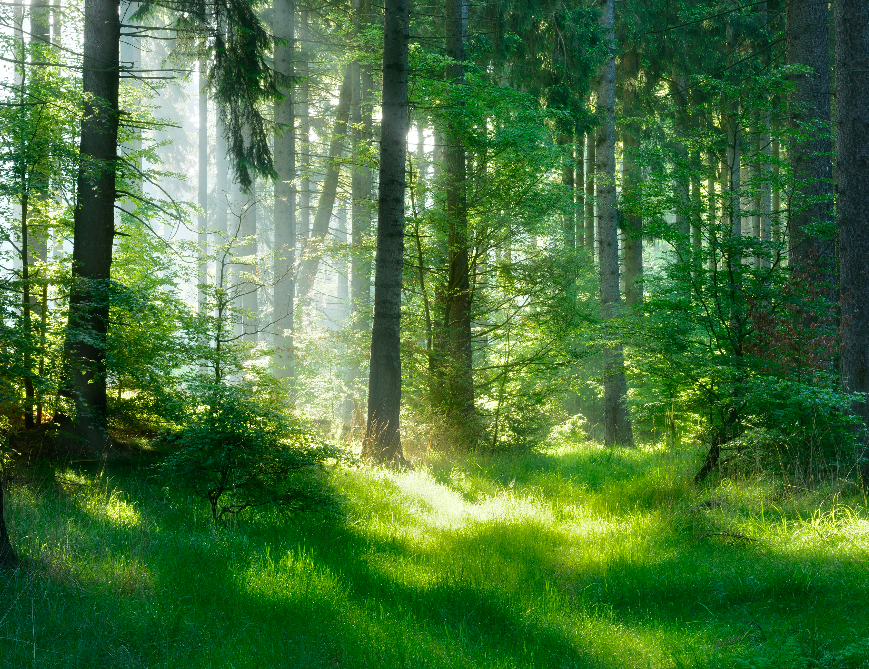In our Autumn 2021 issue, our resident gardening expert, Hans Wieland, took a look at the many health, social and environmental benefits of trees! Enjoy his words below.
Trees Can Be The Answer
Plant and Thrive
by Hans Wieland
Our weekly boy scouts meetings in the sixties in Germany inevitably always ended in the local forest for an orienteering challenge finishing at a campfire with roast potatoes and sausages (and yes, we knew how to put out the fire). We spent hours in the forest, and besides learning about all the trees and their benefits, had great fun. In my teens I spent most Summer Sundays with my parents in the forest, foraging for nuts, berries and mushrooms or simply having a picnic. We did not call it forest gardening, neither did we call it forest bathing. It was simply growing up in a natural environment.
Planting trees for shelter
One of our first farming activities in Ireland in 1986 was actually planting hundreds of trees, mostly broad leaved trees like Ash, Beech, Oak, Alder, Elm, Maples and Birch. More than thirty years later and we have our own forest, even if it’s only a few acres.
We also planted trees around the house, and our garden is now sheltered against the winds from the Southwest by a native hedgerow, and in the North and East by a small stretch of Native Woodland.
The benefits of having trees around the house became very obvious during the heatwave in July of this year, when we could seek shelter from the sun in the cool shade of trees. As the climate warms up, shading in our towns and cities is going to become increasingly important, and trees can perform that role.
Often in a time of crisis, we turn to nature, and the last two years have shown the importance of green spaces, parks and forests for our physical and mental well-being.
Trees and forests have very special health benefits.
The air in a forest is very rich in oxygen, the green colour is calming and the release of essential oils by trees enhance our well- being. Studies have shown that walking through a forest can have a wide array of positive health benefits, including lowered stress, increased creativity, a boost in immune system functions, reduced blood pressure, increased energy and improved sleep.
Planting trees as a climate change solution
The current pandemic has overshadowed the worldwide environmental crisis, only for the wildfires, floods, mudslides and draughts in the last few months to bring into sharp focus that our climate is changing. Again, trees can be the answer. Planting trees can be a part of the solution.
Trees ensure that we have clean air to breathe and pure water to drink.
Reforestation has been recognised as the number one strategy to stop global warming, according to the Crowther Lab in Switzerland. Native trees planted in the right places sequester carbon in their roots, trunks and branches. Trees contribute to our environment by absorbing pollutants and improving air quality. During the process of photosynthesis, trees take in carbon dioxide and produce the oxygen we breathe. Not only do trees preserve soil and hold it together, they actually increase its fertility. Trees and forests slow the flow of water through landscapes and conserve water. They provide food and habitat for wildlife and are important for biodiversity.
A few interesting tree facts (source: The Royal Parks UK)
• The canopies of trees act as a physical air filter. One tree can absorb and remove up to 1.7 kg of pollutants.
• It is estimated that trees can reduce the temperature in a city by up to 7 degrees.
• Trees can help prevent flooding and soil
erosion, absorbing thousands of litres of stormwater.
• Over 20 species of trees in Ireland have medicinal properties.
• One mature oak tree can be home to as many as 500 different species.
• One acre of forest absorbs six tons of carbon dioxide and puts out four tons of oxygen. This is enough to meet the annual needs of 18 people.
What we all can do
Planting an edible hedge, a small woodland, a broad leaved tree or a fruiting tree is not only a great way to offset our carbon footprint, it provides food, shelter and recreational space. Everybody can do it. Even a few trees can make a difference, and they can be harvested after a few years.
Can we just plant trees in our garden?
You don’t need permission, but you do need to think about what species will grow where you live, and also how big trees could get. You need to think about the tree’s distance from your house, underground drains, or overhead power lines, and make sure it is going to be in a place where it can grow without having any adverse impact. You need to think about the effect on your neighbours, too, and talk to them. Smaller species can include apple trees or rowan.
Aftercare is also important. To make sure your tree or trees will grow, pruning is sometimes required.
Trees to begin your journey with
Hawthorn trees are found throughout the Irish countryside and are great for planting native hedges.
The Elder is another iconic tree in the Irish countryside. The immune enhancing properties of elder berries are renowned in Europe and the tree is a common feature around farmhouses.
The Birch, easily spotted because of the white bark, is one of the first trees in Spring to produce new leaves and thereby marks the ‘new beginning’.
Hans Wieland works and teaches at Neantog Kitchen Garden School in Cliffony, Co.Sligo.


